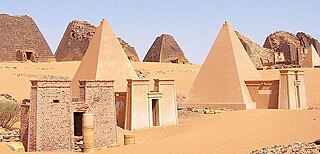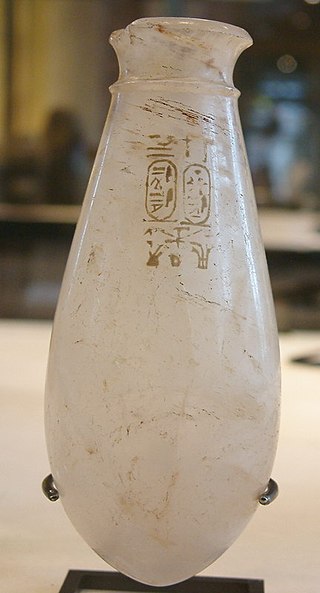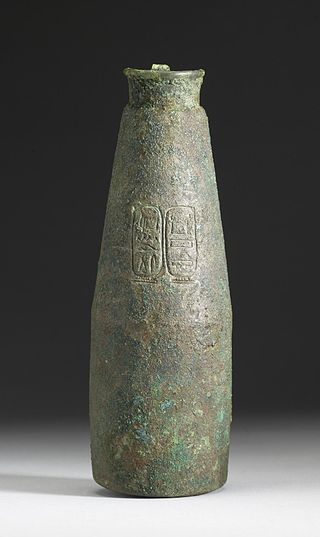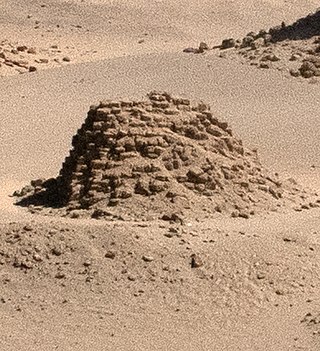
Psamtik II, known by the Graeco-Romans as Psammetichus or Psammeticus, was a king of the Saite-based Twenty-sixth Dynasty of Egypt. His prenomen, Nefer-Ib-Re, means "Beautiful [is the] Heart [of] Re." He was the son of Necho II.

Meroë was an ancient city on the east bank of the Nile about 6 km north-east of the Kabushiya station near Shendi, Sudan, approximately 200 km north-east of Khartoum. Near the site is a group of villages called Bagrawiyah. This city was the capital of the Kingdom of Kush for several centuries from around 590 BC, until its collapse in the 4th century AD. The Kushitic Kingdom of Meroë gave its name to the "Island of Meroë", which was the modern region of Butana, a region bounded by the Nile, the Atbarah and the Blue Nile.

The Third Intermediate Period of ancient Egypt began with the death of Pharaoh Ramesses XI in 1077 BC, which ended the New Kingdom, and was eventually followed by the Late Period. Various points are offered as the beginning for the latter era, though it is most often regarded as dating from the foundation of the Twenty-Sixth Dynasty by Psamtik I in 664 BC, following the departure of the Nubian Kushite rulers of the Twenty-fifth Dynasty after they were driven out by the Assyrians under King Ashurbanipal. The use of the term "Third Intermediate Period", based on the analogy of the well-known First and Second Intermediate Periods, was popular by 1978, when British Egyptologist Kenneth Kitchen used the term for the title of his book on the period. While Kitchen argued that the period was 'far from being chaotic' and hoped that his work would lead to the abolishment of the term, with his own preference being the 'Post-Imperial epoch', his use of the term as a title seems only to have entrenched the use of the term.

The Twenty-third Dynasty of Egypt is usually classified as the third dynasty of the ancient Egyptian Third Intermediate Period. This dynasty consisted of a number of Meshwesh kings, who ruled either as pharaohs or as independent kings of parts of Upper Egypt from 880 BC to 720 BC, and pharaohs from 837 BC to 728 BC.

Kashta was an 8th century BCE king of the Kushite Dynasty in ancient Nubia and the successor of Alara. His nomen k3š-t3 "of the land of Kush" is often translated directly as "The Kushite". He was succeeded by Piye, who would go on to conquer ancient Egypt and establish the Twenty-Fifth Dynasty there.

Harsiotef was a Kushite King of Meroe.

Nastasen was a king of Kush who ruled the Kingdom of Kush from 335 to 315/310 BCE. According to a stela from Dongola, his mother was named Queen Pelkha and his father may have been King Harsiotef. His successor was Aryamani.

Baskakeren was a king of Kush. He was likely a son of King Malewiebamani and the younger brother of King Amanineteyerike. He succeeded King Amanineteyerike to the throne.

Gaius Petronius or Publius Petronius was the second and then fourth Prefect of Roman Aegyptus.

Atlanersa was a Kushite ruler of the Napatan kingdom of Nubia, reigning for about a decade in the mid-7th century BC. He was the successor of Tantamani, the last ruler of the 25th Dynasty of Egypt, and possibly a son of Taharqa or less likely of Tantamani, while his mother was a queen whose name is only partially preserved. Atlanersa's reign immediately followed the collapse of Nubian control over Egypt, which witnessed the Assyrian conquest of Egypt and then the beginning of the Late Period under Psamtik I. The same period also saw the progressive cultural integration of Egyptian beliefs by the Kushite civilization.

The Kingdom of Kush, also known as the Kushite Empire, or simply Kush, was an ancient kingdom in Nubia, centered along the Nile Valley in what is now northern Sudan and southern Egypt.

Nasakhma (Nasakhmaqa) was a Kushite King of Meroe. He was the successor of king Siaspiqa.

Malewiebamani was a Kushite King of Meroe.

Siaspiqa was a ruler of the Kushite kingdom of Meroë reigning for close to twenty years in the first half of the 5th century BC. Very little is known of Siaspiqa's activities beyond the construction of his pyramid at Nuri, now known as Nuri 4. The pyramid and its chapel have yielded several inscribed stelas bearing his name as well as numerous artefacts suggesting a once rich burial. Nothing is known for certain on the relations between Siaspiqa and his predecessor Amaniastabarqa and successor Nasakhma. Equally uncertain is the identity of his consort, with queen Pi'ankhqewqa buried in the nearby Nuri 29 conjectured for that role.

Talakhamani was a Kushite King of Meroe during the second half of the 5th century BCE. No prenomen is known, and his nomen is Talakhamani. He may have been a son of Nasakhma and a younger brother of Malewiebamani. It is also possible Talakhamani is a son of Malewiebamani.

The Twenty-fifth Dynasty of Egypt, also known as the Nubian Dynasty, the Kushite Empire, the Black Pharaohs, or the Napatans, after their capital Napata, was the last dynasty of the Third Intermediate Period of Egypt that occurred after the Nubian invasion.

Amaninatakilebte was a Meroitic king who ruled in the 6th century, probably between 538 to 519 BC at Napata. He succeeded King Analmaye and was in turn succeeded by King Karkamani. Like others of his dynasty, he was discovered buried among the pyramid chambers at Nuri, specifically Nuri 10. These remains, along with engraved blocks at Meroe, are the only known records of the ruler. Also significant is the gold cylinder discovered with the ruler in this pyramid, not unlike those found buried with King Aspelta in Nuri 8, but the function of which remains obscure.

Amaniastabarqa was a Kushite king of Meroë who ruled in the late Sixth or early Fifth centuries BC, c. 510–487 BCE.

Karkamani was a Meroitic king who ruled in the 6th century, probably between 519 to 510 BC at Napata. He succeeded King Amaninatakilebte and was in turn succeeded by King Amaniastabarqa. Like others of his dynasty, he was discovered buried among the pyramid chambers at Nuri, specifically Nuri 7.





















